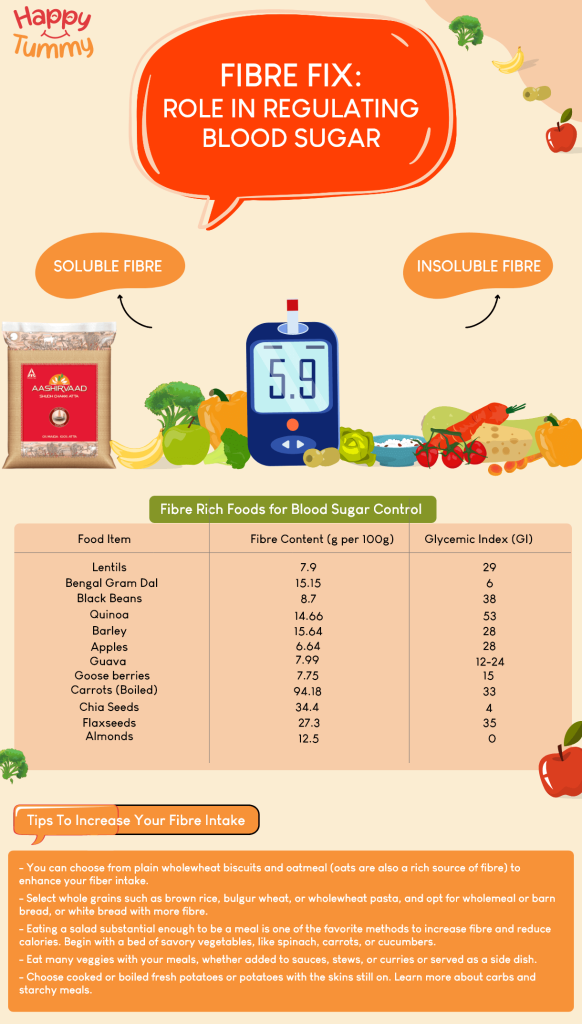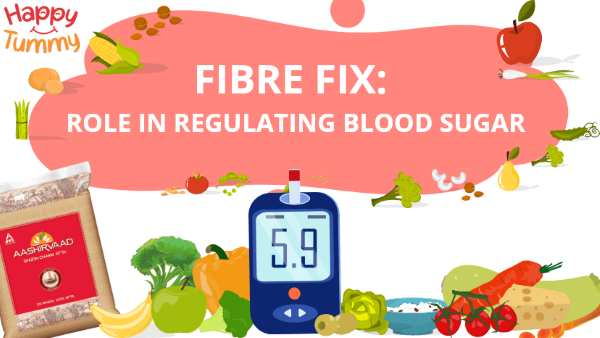Table of Contents
Your regular habits determine your blood sugar levels. For example, you could have stable blood sugar levels when you exercise frequently, eat meals that balance protein and healthy fat well, stay hydrated, control your stress levels, and get enough sleep.
However, your blood sugar levels may rise if you spend most of the day sitting down, neglect to eat breakfast, and often consume processed meals that are heavy in added sugar, refined carbs, and saturated fat.
However, there’s one habit that many people with diabetes and prediabetes might not even be aware they have—one that actually makes it harder for them to maintain their blood sugar levels rather than easier.
Are you set to hear the response? Eating too few carbohydrates high in fibre is the cause. Yes. And you might wonder why this is relevant. Read the article to understand how eating more fibre can help you balance your blood sugar levels.
Role of Fibre in Blood Sugar Control
When you want to achieve stable blood sugar, it’s easy to focus on the quantity over the quality of carbs you consume. However, it is essential to consider if your carbs have fibre. You can achieve that balance by gradually increasing your fibre consumption.
For further clarity, let’s discuss the two fiber types that might help regulate blood sugar.
1. Soluble Fibre
As the name suggests, soluble fibre forms a gel-like substance in the gut when it mixes with water. This gel-like substance may help slow down glucose absorption, manage blood sugar spikes, and reduce the risk of type 2 diabetes [1].
Thus, in addition to giving digestive hormones more time to work, soluble fibre slows down the pace at which the small intestine absorbs carbohydrates by gelling with water.
Soluble fibre may also contribute to a lower risk of insulin resistance. When the body can no longer use its insulin as effectively, it is in insulin resistance. If this condition persists, type 2 diabetes may result[2].
People with higher-than-normal levels of fat surrounding their abdominal organs, such as the liver, pancreas, and intestines, are known to develop insulin resistance. Visceral fat is the term for this type of fat[3]. Increased soluble fibre consumption reduces the build-up of visceral fat by naturally reducing appetite and preventing overeating.
2. Insoluble Fibre
Then there’s insoluble fibre, which doesn’t dissolve in water and remains intact as it travels through your intestines. Insoluble fibre prevents constipation by giving stools more volume and moisture, facilitating the bowel’s ability to push its contents through gradually.
Maintaining good digestion for optimal food absorption becomes crucial in order to control blood sugar[4]. People with diabetes will want to balance having food with a good source of insoluble fibre and keeping blood glucose levels stable.
Fibre Rich Foods for Blood Sugar Control

A diet that is friendly to blood sugar levels must include fibre. As was already noted, fibre functions in our stomachs like a mesh, slowing the rate at which glucose exits the digestive system and enters the bloodstream.
Fibre only naturally occurs in plant meals; thus, the most excellent method to boost our fibre intake is to put more plants on our plates. Fibre is found in all plants, but some are supercharged or offer a large amount of fibre in a minimal volume.
Here are some supercharged high-fibre foods along with glycemic index:
| Food Item | Fibre Content (per 100 gm)[5] | Glycemic Index (GI) [6] |
| Lentils | 7.9 | 29 |
| Bengal Gram Dal | 15.15 | 6 |
| Black Beans | 8.7 | 38 |
| Quinoa | 14.66 | 53 |
| Barley | 15.64 | 28 |
| Apples | 6.69 | 38 |
| Guava | 7.99 | 12-24 |
| Goose Berries | 7.75 | 15 |
| Carrots( Boiled) | 94.18 | 33 |
| Chia Seeds | 34.4 | 4 |
| Flaxseeds | 27.3 | 35 |
| Almonds | 12.5 | 0 |
For knowledge on fibre food items, refer to our insightful article ‘Fibre Fuel: Top Vegetarian Foods for Weight Loss’ and make your journey to Happy Tummy exciting and yummy.
Tips To Increase Your Fibre Intake
A healthy, balanced diet may not be achieved by consuming an excessive amount of one particular food type; therefore, obtaining your fibre from various sources is critical.
- brown rice, bulgur wheat, or wholewheat pasta, and opt for wholemeal or barn bread, or white bread with more fibre.
If you’re looking for high fibre meal options, look no further than AASHIRVAAD WHOLE WHEAT ATTA. Direct from the farmers, Aashirvaad provides you with the best whole-wheat grains.
The finest grains, which are thick and have a golden amber hue, go into making atta. With contemporary “chakki-grinding” technology, Aashirvaad creates atta that contains 100% Sampoorna Atta and 0% maida.
Sample Menu
The Indian Council for Medical Research (ICMR) recommends consuming 25g of dietary fiber daily for women and 30 gm daily for men[7]. An intake of 25g of dietary fiber per 1000 calories is considered optimum for those with diabetes.
A sample of how to incorporate more fibre into your regular diet is given below.
Breakfast
- Moong Dal Cheela: 3 nos.
- Tomato Chutney: 2 tbsp
- Mint Curd Dip: 1 small bowl
Mid-Morning Snack
- Fruit Yogurt (no sugar): 1 small bowl
Lunch
- Multigrain Laccha Paratha: 1 medium
- Rice: 1 small bowl
- Veg Makhani Gravy: 1 small bowl
- Tawa Paneer Sabji: 1 small bowl
- Lassi (sugarless): 1 small glass
Evening Snack
- Tea: 1 medium cup
- Veg Cutlet: 1 no.
Dinner
- Multigrain Roti: 2 medium
- Soya Chaap Gravy: 1 small bowl
- Carrot Cucumber Salad: 1 small bowl
- Sweet Curd: 1 small bowl
Bedtime
- Milk (sugarless): 1 medium cup
This sample meal plan provides 25-30g of fiber per day. This sample menu is for general use and those with diabetes.
The scenario above is merely meant to serve as an illustration; the amount of fibre in any given dish might vary depending on how it is prepared and consumed in quantity.
The nutrition label on the back or side of most pre-packaged foods might provide information on the food’s dietary fibre content.
Planning your meals may be difficult sometimes, and you’re always looking for new ways to increase your fibre intake. But you’re not sure how to go about it.
You don’t have to worry, though, since Aashirvaad Atta and a team of knowledgeable nutritionists developed the My Meal Plan, which estimates your daily fibre intake and creates a meal plan that satisfies recommended intake guidelines.
Is it possible to reverse diabetes with fiber?
Diabetes is a lifestyle disease that is caused by many factors. Diabetes may not be reversed but can be kept under control with specific changes in lifestyle, such as diet, exercise, and regular intake of prescribed medications. Increased fiber consumption leads to better blood glucose management in type 2 diabetics. Dietary fiber is that part of the food that is not digested in the gut and is considered an unavailable carbohydrate., so unlike other carbohydrates, it does not increase blood sugar.
The Bottom Line
Instead of shunning all carbohydrates because you think they’ll spike your blood sugar, concentrate on eating carbs high in fibre, as they have been shown to help with blood sugar regulation.
Not only can you manage your blood sugar levels by eating a diet rich in fibre-rich fruits, vegetables, beans, legumes, nuts, seeds, and whole grains, but you’ll also lower your risk of developing diabetes-related problems like heart disease and other ailments like obesity.
Fibre, combined with high-quality protein and good fats, is vital to a well-rounded diet. If your meal plans include more veggies, fruit, and bran, you won’t be lacking in healthy forms of fibre when following a low-carb diet.
You’ll be able to eat various foods, and your plate will look brighter and more vibrant.
If you’re concerned about how to increase fibre intake or are prone to conditions such as diabetes, talk to our healthcare provider about what you may do. Reach out to our certified nutritionist for a 45-minute consultation and get a customized nutrition plan created just for you.
Frequently Asked Questions
Certain fibres might aid in relieving constipation by maintaining regularity. But if you’ve just started eating a lot of fibre and you’ve noticed that you have increased gas. Any fibre can result in flatulence; however, different sources of fibre may produce varying amounts of gas because bacteria differ in their capacity to digest other kinds of fibre.
Although there are many reasons why people experience constipation and bloating, these symptoms are frequently caused by a diet low in fibre. Fibre provides your stools with more volume and bulk, which your colon can process and pass.
You could occasionally experience confusion over your digestive quotient. With Aashirvaad Digestive Quotient, things do, however, become more manageable.
The Digestion Quotient test, created by Aashirvaad Atta with Multigrains and a team of professional nutritionists, determines your digestion score on a scale of 100.
Soluble fibre can help manage the consequences of diabetes by lowering blood sugar and cholesterol. Apples, bananas, oats, peas, black beans, lima beans, sprouts, and avocados are high in soluble fibre.
Increase your daily intake of dietary fibre by 15 g to 35 g if you have prediabetes, type 1 diabetes, or type 2 diabetes. An intake of 25g of dietary fiber per 1000 calories is considered optimum for those with diabetes. Choosing whole grain foods instead of refined grain products is a useful strategy to enhance fibre intake.
















